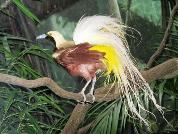 The male bird of paradise with its strikingly colourful plumage is an amazing spectacle in the jungle of New Guinea jungle. In the mating season, its bright red, yellow and blue feathers stand out against the green of the rainforest. This special bird belongs to one of the most beautiful in the world and it has inspired many an artist. Papuan peoples, on in the Indonesian part of the island and n Papua New Guinea (PNG), still use the feathers of this bird to embellish their headdresses. The male of the Great Bird of Paradise with its vibrant colour and fluffy, scarlet feathers, is the most spectacular-looking member of this very flamboyant species. For many Papuans the Bird of Paradise is a symbol of solidarity.
The male bird of paradise with its strikingly colourful plumage is an amazing spectacle in the jungle of New Guinea jungle. In the mating season, its bright red, yellow and blue feathers stand out against the green of the rainforest. This special bird belongs to one of the most beautiful in the world and it has inspired many an artist. Papuan peoples, on in the Indonesian part of the island and n Papua New Guinea (PNG), still use the feathers of this bird to embellish their headdresses. The male of the Great Bird of Paradise with its vibrant colour and fluffy, scarlet feathers, is the most spectacular-looking member of this very flamboyant species. For many Papuans the Bird of Paradise is a symbol of solidarity.
Content:
1. Habitat of the bird of paradise
2. Fanciful appearance a product of evolution
3. A polygamous species
4. Its cultural significance
5. Its significance for Papuans in the Netherlands
6. A two-thousand-year old trade
7. On the other side of the globe
8. Bird of paradise as symbol
9. Links
10. Sources
1.Habitat of the bird of paradise
This bird occurs on New Guinea and its surrounding islands. Of the 43 species, 38 actually occur on the island of New Guinea itself. Six species occur on the Moluccas, a group of islands near New Guinea, and there are four species in north east Australia. According to geologists, Australia was attached to New Guinea over 10,000 years ago, but it is now separated by Torres Strait
The bird of paradise is a fruit eater. Fruit is its staple diet, but seeds, insects, frogs and small reptiles are also eaten.
The birds have wonderful names such as Banner Bearer, King Bird of Paradise and  Lintstaartastrapia. The black crow and the jay are in fact related to the bird of paradise. Some species are black and resemble the black crow but most birds of paradise are brightly coloured with long tail feathers, making them look more like a peacock than a crow. With their brightly coloured plumage, the males lure the females which are a dull brown and not at all colourful. Female birds live in small groups but the males are usually solitary.
Lintstaartastrapia. The black crow and the jay are in fact related to the bird of paradise. Some species are black and resemble the black crow but most birds of paradise are brightly coloured with long tail feathers, making them look more like a peacock than a crow. With their brightly coloured plumage, the males lure the females which are a dull brown and not at all colourful. Female birds live in small groups but the males are usually solitary.
In the mating season, the male makes a very peculiar and very loud call in order to lure the female. To impress his mate, he shows off his lovely plumes using quite a complicated mating ritual (click here). He repeatedly jumps from one branch to the next, and hangs up side down to make his colourful tail stand out even more. A group of females dances wildly around him. This dancing ritual always occurs on a particular spot which is known as ‘lek’. In the end one ‘lucky female’ is selected for a mate.
2. Fanciful appearance product of evolution
According to biologists, the males of this species have become more and more colourful because of the competition among its kind. The most beautiful birds were 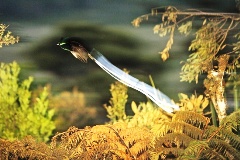 the most successful at reproduction. They got the chance to develop such fancy tails as there are no major predators that they need to avoid. Flying around with such a long tail would otherwise have been a hazard for the tail feather can reach 60 cm and can sometimes be even longer. For Example, the Long Tailed Bird of Paradise Magpie is 1.17m in length, of which the tail measures 93cm. Thus a relatively clumsy tail has endured (evolutionary) history, because it became important to the survival of its kind.
the most successful at reproduction. They got the chance to develop such fancy tails as there are no major predators that they need to avoid. Flying around with such a long tail would otherwise have been a hazard for the tail feather can reach 60 cm and can sometimes be even longer. For Example, the Long Tailed Bird of Paradise Magpie is 1.17m in length, of which the tail measures 93cm. Thus a relatively clumsy tail has endured (evolutionary) history, because it became important to the survival of its kind.
3. A polygamous species
Of the 43 species, 8 are monogamous but the remaining 35 are polygamous. The 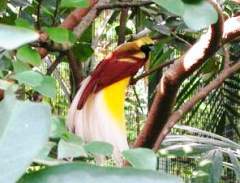 birds that are monogamous are much less colourful. However, the polygamous variety with its fanciful long tail attracts many females during its life. It often has a number of specially coloured threads in amongst its tail feathers. Some birds of paradise have an unusual crown of feathers on top of its head.
birds that are monogamous are much less colourful. However, the polygamous variety with its fanciful long tail attracts many females during its life. It often has a number of specially coloured threads in amongst its tail feathers. Some birds of paradise have an unusual crown of feathers on top of its head.
Birds of paradise build nests from soft materials such as leaves, ferns and vines, usually in a fork of a branch. The shape of most varieties is cup-shaped and among the polygamous ones only the female builds the nest. She sits on the eggs, rears the young and also provides the ‘after care’. Among the monogamous species, the male does help with caring for the young. As far as we know, only the King Bird of Paradise nests in the hollow of a tree. There may be others but not all species have been studied by scientists. It 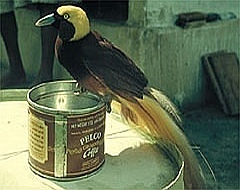 costs time and money to undertake expeditions in the rough and rugged landscape of New Guinea. In 2005 the beautiful male of the Berlepsch Parotia Bird of Paradise was observed for the very first time. Most of the scientific knowledge about birds of paradise was gathered during the time that the province of Papua was still a Dutch colony. These days there is rarely an expedition. An additional complication is the fact that Indonesia prefers not to allow prying eyes. Its independent neighbour, PNG, also has a rough landscape and is not wealthy enough to set up large scale scientific research.
costs time and money to undertake expeditions in the rough and rugged landscape of New Guinea. In 2005 the beautiful male of the Berlepsch Parotia Bird of Paradise was observed for the very first time. Most of the scientific knowledge about birds of paradise was gathered during the time that the province of Papua was still a Dutch colony. These days there is rarely an expedition. An additional complication is the fact that Indonesia prefers not to allow prying eyes. Its independent neighbour, PNG, also has a rough landscape and is not wealthy enough to set up large scale scientific research.
4. Its cultural significance
The bird of paradise plays a significant role in Papua culture. Many tribes use the  feathers for decorative head gear. The feathers are also used for ceremonial dress, traditional skirts and other women’s clothing. This special clothing is often passed on from one generation to the next. As birds of paradise live right at the top of trees, catching them involves a tricky procedure.
feathers for decorative head gear. The feathers are also used for ceremonial dress, traditional skirts and other women’s clothing. This special clothing is often passed on from one generation to the next. As birds of paradise live right at the top of trees, catching them involves a tricky procedure.
Some Papua tribes have tales in which the birds of paradise are described as ‘birds of the gods’. In 16th Century Europe it was also thought that these birds came directly from paradise. The first birds of paradise that arrived in Europe were mounted without legs or wings. These had been prepared by indigenous Papuans. The first European to set eyes on a bird of paradise was Antonio Pigafetta from Venice, who sailed to the East Indies as an assistant of the explorer Ferdinand 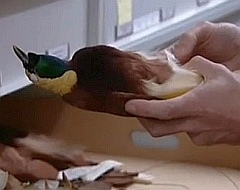 Megellan at the beginning of the 16th century. In his diary he recorded what the indigenous people had told him: that these birds came from a paradise on earth and were called bolon diuata (‘birds from God). Because of this, a legend arose in Europe that these birds flew eternally up through the clouds, drinking a special cloud dew to stay alive. They had obtained their colours by flying close to the sun. One thought that these birds simply fell out of the sky at the end of their life . Such birds did not need any legs. (It took 150 years before birds of paradise came to Europe in their complete state ).The bird acquired its name because of the legend that it always flew around in paradise.
Megellan at the beginning of the 16th century. In his diary he recorded what the indigenous people had told him: that these birds came from a paradise on earth and were called bolon diuata (‘birds from God). Because of this, a legend arose in Europe that these birds flew eternally up through the clouds, drinking a special cloud dew to stay alive. They had obtained their colours by flying close to the sun. One thought that these birds simply fell out of the sky at the end of their life . Such birds did not need any legs. (It took 150 years before birds of paradise came to Europe in their complete state ).The bird acquired its name because of the legend that it always flew around in paradise.
5. Its significance for Papuans in the Netherlands
Most Papuan families living in the Netherlands used to have a mounted bird of paradise , with or without legs. According to Dawiday Hanasbei, who works for 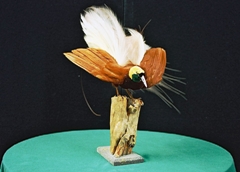 PACE, this bird represented their feeling of commitment to Papua. He said that his father had a stuffed bird of paradise in his luggage when he arrived in the Netherlands in 1960. “He married my mother, a Dutch woman, in 1961 and he died in 1983 when he was 44 years old. A mounted bird of paradise in your house confirmed that you were in the home of a ‘Dutch Papuan’. The bird was always sitting at a prominent spot, mounted on the wall or a branch of a tree. At our house it hung next to a crown pigeon, another beautiful bird from Papua. As Papuans, we are proud of the loveliest bird on earth because of its sheer beauty, its purity and its uniqueness. The bird of paradise represented a counterbalance at a time when we were daily confronted with the overwhelming western culture of the Netherlands. In the meantime, the urge to own a bird of paradise has faded among the third generation of Papuan descent. Neither the Papuan culture , nor the bird of paradise is a necessity of life for the young Papuans of today”, Dawiday observed at the end of the interview on the significance of the bird of paradise for Papuans living in the Netherlands.
PACE, this bird represented their feeling of commitment to Papua. He said that his father had a stuffed bird of paradise in his luggage when he arrived in the Netherlands in 1960. “He married my mother, a Dutch woman, in 1961 and he died in 1983 when he was 44 years old. A mounted bird of paradise in your house confirmed that you were in the home of a ‘Dutch Papuan’. The bird was always sitting at a prominent spot, mounted on the wall or a branch of a tree. At our house it hung next to a crown pigeon, another beautiful bird from Papua. As Papuans, we are proud of the loveliest bird on earth because of its sheer beauty, its purity and its uniqueness. The bird of paradise represented a counterbalance at a time when we were daily confronted with the overwhelming western culture of the Netherlands. In the meantime, the urge to own a bird of paradise has faded among the third generation of Papuan descent. Neither the Papuan culture , nor the bird of paradise is a necessity of life for the young Papuans of today”, Dawiday observed at the end of the interview on the significance of the bird of paradise for Papuans living in the Netherlands.
6. A two-thousand-year old trade
Since the beginning of the current era, birds of paradise have been sought after as a 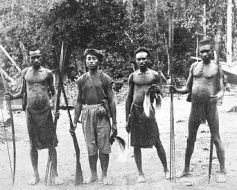 status symbol in China. So trading its skins and feathers is more that 2000 years old. As early as 1596, the Dutch explorer, Jan Huygens van Linschoten already had an enthusiastic entry in his log book about the bird of paradise. The first specimens were brought in during trade expeditions in the 16th century and it soon lead to a brisk trade. During the 19th century, the first live birds are brought in . Fashion designers started using the lovely feathers for ladies’ hats. Between 1880 and 1890, the bird of paradise was well on its way to being decimated because of the excessive use of feathers for the hats of vain individuals. The relentless hunting continued and by the beginning of the 20th century about 50.000 birds were being traded each year.
status symbol in China. So trading its skins and feathers is more that 2000 years old. As early as 1596, the Dutch explorer, Jan Huygens van Linschoten already had an enthusiastic entry in his log book about the bird of paradise. The first specimens were brought in during trade expeditions in the 16th century and it soon lead to a brisk trade. During the 19th century, the first live birds are brought in . Fashion designers started using the lovely feathers for ladies’ hats. Between 1880 and 1890, the bird of paradise was well on its way to being decimated because of the excessive use of feathers for the hats of vain individuals. The relentless hunting continued and by the beginning of the 20th century about 50.000 birds were being traded each year.
The Dutch trade in birds of paradise kicked off from in March 1910 when Hollandia, now Jayapura, was founded. The islet Metu Debi, in the estuary at Jafeta Bay  between Tobatti and Engros had been the main meeting place for bird of paradise traders around 1900. However. Hollandia only profited from the trade for a short period of time. Initially, the trade of feathers spurred on the growth of this town but in 1912 hunting birds of paradise became illegal and by 1922 a trade embargo put a stop to the trade. After this the numbers of birds of paradise started to rise very slowly. Local Papuans were allowed to hunt these birds to accommodate traditional customs but these birds were no longer being exported from former Dutch New Guinea. However ,since the transfer to Indonesia, the illegal trade has started up again. Today the bird is still popular, not only in China , but also in Europe and America.
between Tobatti and Engros had been the main meeting place for bird of paradise traders around 1900. However. Hollandia only profited from the trade for a short period of time. Initially, the trade of feathers spurred on the growth of this town but in 1912 hunting birds of paradise became illegal and by 1922 a trade embargo put a stop to the trade. After this the numbers of birds of paradise started to rise very slowly. Local Papuans were allowed to hunt these birds to accommodate traditional customs but these birds were no longer being exported from former Dutch New Guinea. However ,since the transfer to Indonesia, the illegal trade has started up again. Today the bird is still popular, not only in China , but also in Europe and America.
7. On the other side of the globe
In 1909, Sir Willain Ingram, a member of the British parliament, transported the Giant Bird of Paradise (Paradisaea Aboda) to little Tobago at the other side of the 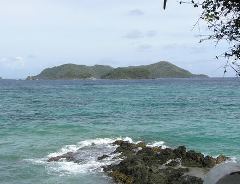 world, a small island situated about 2.4 km out along the northeast coast of Taboga, in the Republic of Tobago and Trinidad on the other side of the globe. He took it to this small island, just one square kilometre in size, to save the in New Guinea over-hunted bird from extinction. He introduced around 45 young birds to the island of Little Tobago, which since then has also become known as the Island of the Bird of Paradise. After his death in 1924, his heirs presented the island as a wildlife sanctuary to the government of Trinidad and Tobago. The birds managed to survive at least up until 1958, when they were filmed by a film team from the National Geographic. After 1963, there has not been any reliable data to confirm that they have survived. In that year the island was hit by Hurricane Flora, which is supposed to have destroyed all life on Little Tobago.
world, a small island situated about 2.4 km out along the northeast coast of Taboga, in the Republic of Tobago and Trinidad on the other side of the globe. He took it to this small island, just one square kilometre in size, to save the in New Guinea over-hunted bird from extinction. He introduced around 45 young birds to the island of Little Tobago, which since then has also become known as the Island of the Bird of Paradise. After his death in 1924, his heirs presented the island as a wildlife sanctuary to the government of Trinidad and Tobago. The birds managed to survive at least up until 1958, when they were filmed by a film team from the National Geographic. After 1963, there has not been any reliable data to confirm that they have survived. In that year the island was hit by Hurricane Flora, which is supposed to have destroyed all life on Little Tobago.
8. The Bird of Paradise as symbol
The Bird of Paradise is a national symbol for all Papuans on the island of New Guinea, whether they be in PNG or in Papua, Indonesia. In PNG Raggi’s Bird of 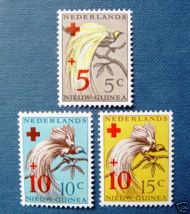 Paradise (Paradisea Raggiana) with its red-brown tail is the national symbol and in the Indonesian Province of Papua, the small bird of paradise or Paradisea Minor with its yellow tail, is used as their symbol. In PNG the red tailed Paradisaea Raggania is depicted on the national flag and it is also the logo for the national carrier, Air Niugini. In the 1950’s images of birds of paradise were on stamps and on bank notes. The Malaysian name for Bird of Paradise is Cenderawasih and in Papua it is regularly used for place names and institutions. Take for example Teluk Ceerawasih (formerly Geelvink Bay) and Universitas Cenderawasih, the university of Papua, in the provincial capital of Jayapura. The name of the main local paper uses Cenderawasih Pos to signify its name.
Paradise (Paradisea Raggiana) with its red-brown tail is the national symbol and in the Indonesian Province of Papua, the small bird of paradise or Paradisea Minor with its yellow tail, is used as their symbol. In PNG the red tailed Paradisaea Raggania is depicted on the national flag and it is also the logo for the national carrier, Air Niugini. In the 1950’s images of birds of paradise were on stamps and on bank notes. The Malaysian name for Bird of Paradise is Cenderawasih and in Papua it is regularly used for place names and institutions. Take for example Teluk Ceerawasih (formerly Geelvink Bay) and Universitas Cenderawasih, the university of Papua, in the provincial capital of Jayapura. The name of the main local paper uses Cenderawasih Pos to signify its name.
9. Links
- YouTube-video: Birds of Paradise. These are some cool birds from a cool place called Papua New Guinea. Islandwantok, 31-07-2006
-Video: In search for the Birds of Paradise van babakoku.eu 15-06-09
- Video: Vanen, Pluimen uit het Paradijs Een film van Miguel A. Garcia en Loïc Degen, 19-06-2009
- Youtube-film: West Papua Paradijsvogel On his trip through West-Papua kwam Ed alsoencountered the bird of paradise (2004).
10. Sources
- Gill, Frank; Wright, Minturn & Donsker, David: IOC World Bird List. (Updated 22-12-2009), complete world list of all existing birds, International Ornithological Congres.
– Browdler Sharpe, Richard (1891) Monograph of the Birds of Paradise, H. Sotheran London.
CRIBB, ROBERT (1997): Vogels van het paradijs en milieu koloniale politiek in Indonesië, 1890-1931. In: Boomgaard, Peter; Columbijn, Freek & Henley, David (red.): Papier landschappen: verkenningen in de milieu geschiedenis van Indonesië: 379-408. KITLV Press, Leiden.
– Clifford B.; Firth, Dawn W. (2009). "Family Paradisaeidae (Birds-of-paradise)". In del Hoyo, Josep; Elliott, Andrew; Christie, David.
- Handbook of the Birds of the World. Volume 14, Bush-shrikes to Old World Sparrows. Barcelona: Lynx Edicions. pp. 404–459.
– Ernst Sutter & Walter Linsenmaier (1955): Paradiesvögel und Kolibris. Bilder aus dem Leben der Tropenvögel. - Zürich.
– Erwin Stresemann (1954): Die Entdeckungsgeschichte der Paradiesvögel. - Journal of Ornithology 95(3-4): 263-291.
– Heads, M (2001),. "Birds of paradise, biogeography and ecology in New Guinea: a review". Journal of Biogeography 28 (7): 893–925.
– Fuller, Errol (January 1997). The Lost Birds of Paradise. Voyageur Press.
– Frith, Clifford B. (1991). Forshaw, Joseph. ed. Encyclopaedia of Animals: Birds. London: Merehurst Press. pp. 228–231.
– Irested, Martin; Jønsson, Knud A ;Fjeldså, Jon; Christidis, Les and Per GP Ericson (2009). An unexpectedly long history of sexual selection in birds-of-paradise. Evolutionary Biolgy 9.
– Cracraft, J en Feinstein, J. (2000): What is not a bird of paradise? Molecular and morphological evidence places Macgregoria in the Meliphagidae and the Cnemophilinae near the base of the corvoid tree.
– Sibley & Ahlquist, J. (1987). "The Lesser Melampitta is a Bird of Paradise" Emu 87: 66-68.
– Frith Clifford B. & Beehler Bruce M. (1998): The Birds of Paradise: Paradisaeidae. Oxford University Press.
– Harrison, Thomas P. (1960). "Bird of Paradise: Phoenix Redivivus". Isis 51 (2): 173–180.
– Jobling, James A. (1991). A Dictionary of Scientific Bird Names. Oxford: Oxford University Press.
– Advice and comments: Max Ireeuw